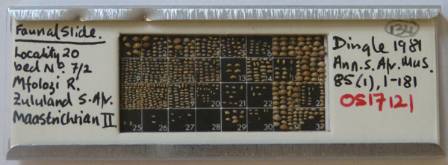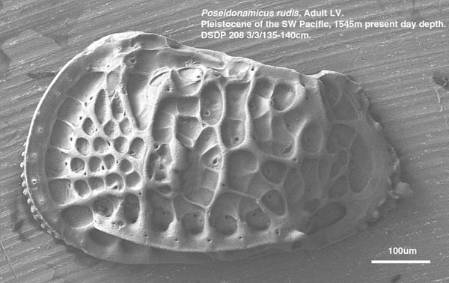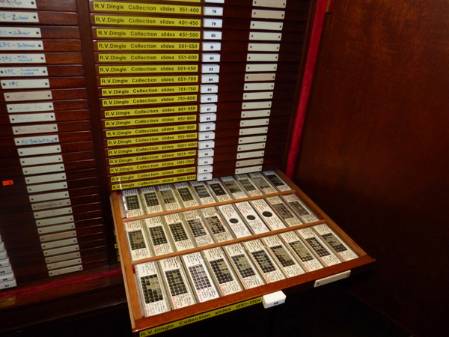In 2011 we accepted a donation of 2,500 microscope slides containing over 90,000 ostracods from the personal collection of Prof. Richard Dingle. Richard has been visiting the Museum for almost 10 years now and has organised, documented and subsequently donated this major collection.
The material in the collection represents a lifetime of work on ostracods and underpins research that has helped illuminate some major questions in evolution, detailed the movements of ancient continents and shown patterns of migration of ostracods across oceans. Some important type specimens are also included in the collection.
One of the slides that Richard has prepared before donation to the Museum. The total length is 7cm. Each of these specimens has been positioned on the slides during visits to the Museum by Richard; a very time consuming and painstaking process.
- The opening of the Atlantic Ocean
From the late Jurassic (very roughly 150 million years ago) the ancient continental mass of Gondwana began to split, creating the Atlantic and Indian oceans. This left the Agulhus Bank off the tip of southern Africa in a central "cross roads" location between warm and cold waters, a situation that persists to the modern day.
Richard was able to show that mid Cretaceous South African ostracod faunas were similar to those of the Falklands, indicating the presence of an Agulhus Bank/Falkland Plateau prior to the plates separating and creating the present day Atlantic Ocean.
- How and when do ostracod species migrate across oceans?
Studying the benthic (bottom dwelling) ostracods from the Agulhus Bank enabled Richard to document the influx of Madagascan type faunas from the emerging Indian Ocean and their onward passage to South America.
Various oceanic barriers to migration existed and were subsequently bridged. The ostracod faunas were able to show the timing of the influx of south/central Atlantic faunas into the SW Indian Ocean.
Richard's work has also contributed to various theories about the migration and sometimes isolation of ostracods lineages across oceans by island hopping. The collection also shows the migration of the important genus Magungaella from pre-glacial to younger glacial high latitude sites.
- Can evolution work in reverse?
In a nutshell, Dollo's Law suggests that once an evolutionary trait has evolved, it can't be un-evolved. Richard's collection of ostracods from Marion Island in the Southern Ocean, shows the re-appearance of eyes in deep water ostracod genera that were previousy considered blind.
Richard proposed a gene-reactivation hypothesis to account for this. The possession of eyes is key to classifying ostracods and evaluating their evolutionary history, a matter of continuing controversy amongst ostracod workers.
An example of Poseidonamicus, one of the deep sea genera of blind ostracods used by Richard Dingle to show that sightedness returned later in geological time in shallow water forms. This example is from the Aberystwyth Collection and photographed by Gene Hunt now at the Smithsonian Institution, Washington.
- What do ostracods tell us about ancient environments and oceans?
It has been suggested that 40 million years ago there was a major global deep sea event that caused a disruption in deep sea populations. Richard's findings derived from Ocean Drilling Programme/ Deep Sea Drilling Programme collection sites, have contributed to discussions and conclusions about this ancient event.
The collection now at the Museum also provides the source data for Richard's triangulation method of palaeo-environment prediction, based on late Cretaceous (roughly 70-85 million year old) ostracods.
Similarly, Richard proposed that ostracod provinces existed around the margins of the ancient continental mass of Gondwana. Examples of these assemblages are also present in the collections he donated to the Museum.
The collection that Richard donated is vast in terms of numbers of specimens and represents a lifetime of work on ostracods. Hopefully it will be remembered not only for the large number of items present but also for the excellent science it backs up. More about Richard Dingle's Collection and his work can be found in a paper published this month in the Journal of Micropalaeontology.





